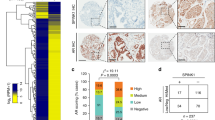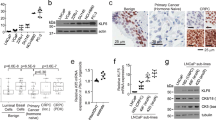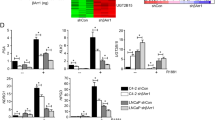Abstract
Mutations in p53 occur at a rate of approximately 70% in hormone-refractory prostate cancer (CaP), suggesting that p53 mutations facilitate the progression of CaP to androgen-independent (AI) growth. We have previously reported that transfection of p53 gain of function mutant alleles into LNCaP, an androgen-sensitive cell line, allows for AI growth of LNCaP in vitro. We herein confirm the in vivo relevance of those findings by demonstrating that the R273H p53 mutation (p53R273H) facilitates AI growth in castrated nude mice. In addition, we demonstrate that H2 relaxin is responsible for facilitating p53R273H-mediated AI CaP. H2 relaxin is overexpressed in the LNCaP-R273H subline. Downregulation of H2 relaxin expression results in significant inhibition of AI growth, whereas addition of recombinant human H2 relaxin to parental LNCaP promotes AI growth. Inhibition of AI growth was also achieved by blocking expression of LGR7, the cognate receptor of H2 relaxin. Chromatin immunoprecipitation analysis was used to demonstrate that p53R273H binds directly to the relaxin promoter, further confirming a role for H2 relaxin signaling in p53R273H-mediated AI CaP. Lastly, we used a reporter gene assay to demonstrate that H2 relaxin can induce the expression of prostate-specific antigen via an androgen receptor-mediated pathway.
This is a preview of subscription content, access via your institution
Access options
Subscribe to this journal
Receive 50 print issues and online access
$259.00 per year
only $5.18 per issue
Buy this article
- Purchase on Springer Link
- Instant access to full article PDF
Prices may be subject to local taxes which are calculated during checkout








Similar content being viewed by others
Abbreviations
- AI:
-
androgen independent
- CaP:
-
prostate cancer
- ChIP:
-
chromatin immunoprecipitation
- R273H p53 mutation:
-
p53R273H
- CSS:
-
charcoal-stripped serum
- rh:
-
recombinant human
- GOF:
-
gain of function
- LOF:
-
loss of function
- RNAi:
-
RNA interference
References
Affymetrix GeneChip Expression Analysis Technical Manual. Santa Clara, CA.
Amorino GP, Parsons SJ . (2004). Crit Rev Eukaryot Gene Expr 14: 287–300.
Bartsch O, Bartlick B, Ivell R . (2001). Mol Hum Reprod 7: 799–809.
Bathgate RA, Samuel CS, Burazin TC, Gundlach AL, Tregear GW . (2003). Trends Endocrinol Metab 14: 207–213.
Cadwell C, Zambetti GP . (2001). Gene 277: 15–30.
Chan JM, Stampfer MJ, Giovannucci E, Gann PH, Ma J, Wilkinson P et al. (1998). Science 279: 563–566.
Chin KV, Ueda K, Pastan I, Gottesman MM . (1992). Science 255: 459–462.
Culig Z, Hobisch A, Cronauer MV, Radmayr C, Trapman J, Hittmair A et al. (1994). Cancer Res 54: 5474–5478.
Culig Z, Steiner H, Bartsch G, Hobisch A . (2005). Endocr Relat Cancer 12: 229–244.
Deb S, Jackson CT, Subler MA, Martin DW . (1992). J Virol 66: 6164–6170.
Deb SP, Munoz RM, Brown DR, Subler MA, Deb S . (1994). Oncogene 9: 1341–1349.
Dinjens WN, van der Weiden MM, Schroeder FH, Bosman FT, Trapman J . (1994). Int J Cancer 56: 630–633.
El-Hizawi S, Lagowski JP, Kulesz-Martin M, Albor A . (2002). Cancer Res 62: 3264–3270.
Figueiredo KA, Palmer JB, Mui AL, Nelson CC, Cox ME . (2005). Ann NY Acad Sci 1041: 320–327.
Garibay-Tupas JL, Bao S, Kim MT, Tashima LS, Bryant-Greenwood GD . (2000). J Mol Endocrinol 24: 241–252.
Gittes RF . (1991). N Engl J Med 324: 236–245.
Hanahan D, Weinberg RA . (2000). Cell 100: 57–70.
Heidenberg HB, Sesterhenn IA, Gaddipati JP, Weghorst CM, Buzard GS, Moul JW et al. (1995). J Urol 154: 414–421.
Hsu SY, Kudo M, Chen T, Nakabayashi K, Bhalla A, van der Spek PJ et al. (2000). Mol Endocrinol 14: 1257–1271.
Hsu SY, Nakabayashi K, Nishi S, Kumagai J, Kudo M, Sherwood OD et al. (2002). Science 295: 671–674.
Huggins C, Hodges CV . (1972). CA Cancer J Clin 22: 232–240.
Ivell R, Einspanier A . (2002). Trends Endocrinol Metab 13: 343–348.
Ivell R, Hunt N, Khan-Dawood F, Dawood MY . (1989). Mol Cell Endocrinol 66: 251–255.
Kasamon KM, Dawson NA . (2004). Curr Opin Urol 14: 185–193.
Koul HK, Maroni PD, Meacham RB, Crawford D, Koul S . (2004). Ann NY Acad Sci 1030: 243–252.
Kyprianou N, English HF, Isaacs JT . (1990). Cancer Res 50: 3748–3753.
Lanyi A, Deb D, Seymour RC, Ludes-Meyers JH, Subler MA, Deb S . (1998). Oncogene 16: 3169–3176.
Lee LF, Louie MC, Desai SJ, Yang J, Chen HW, Evans CP et al. (2004). Oncogene 23: 2197–2205.
Li C, Wong WH . (2001). Proc Natl Acad Sci USA 98: 31–36.
Mosmann T . (1983). J Immunol Methods 65: 55–63.
Navone NM, Troncoso P, Pisters LL, Goodrow TL, Palmer JL, Nichols WW et al. (1993). J Natl Cancer Inst 85: 1657–1669.
Nesslinger NJ, Shi XB, deVere White RW . (2003). Cancer Res 63: 2228–2233.
Olivier M, Eeles R, Hollstein M, Khan MA, Harris CC, Hainaut P . (2002). Hum Mutat 19: 607–614.
Palejwala S, Tseng L, Wojtczuk A, Weiss G, Goldsmith LT . (2002). Biol Reprod 66: 1743–1748.
Petrylak DP, Tangen CM, Hussain MH, Lara Jr PN, Jones JA, Taplin ME et al. (2004). N Engl J Med 351: 1513–1520.
Raj GV, Barki-Harrington L, Kue PF, Daaka Y . (2002). J Urol 167: 1458–1463.
Roemer K . (1999). Biol Chem 380: 879–887.
Samuel CS, Tian H, Zhao L, Amento EP . (2003). Lab Invest 83: 1055–1067.
Scian MJ, Stagliano KE, Deb D, Ellis MA, Carchman EH, Das A et al. (2004). Oncogene 23: 4430–4443.
Shah RB, Mehra R, Chinnaiyan AM, Shen R, Ghosh D, Zhou M et al. (2004). Cancer Res 64: 9209–9216.
Sherwood OD . (2004). Endocr Rev 25: 205–234.
Shi XB, Gandour-Edwards R, Beckett LA, Deitch AD, de Vere White RW . (2004a). BJU Int 94: 996–1002.
Shi XB, Ma AH, Tepper CG, Xia L, Gregg JP, Gandour-Edwards R et al. (2004b). Prostate 60: 257–271.
Shi XB, Nesslinger NJ, Deitch AD, Gumerlock PH, deVere White RW . (2002). Prostate 51: 59–72.
Silvertown JD, Geddes BJ, Summerlee AJ . (2003a). Endocrinology 144: 3683–3691.
Silvertown JD, Ng J, Sato T, Summerlee AJ, Medin JA . (2006). Int J Cancer 118: 62–73.
Silvertown JD, Summerlee AJ, Klonisch T . (2003b). Int J Cancer 107: 513–519.
Stemmermann GN, Mesiona W, Greenwood FC, Bryant-Greenwood GD . (1994). J Endocrinol 140: 321–325.
Tannock IF, de Wit R, Berry WR, Horti J, Pluzanska A, Chi KN et al. (2004). N Engl J Med 351: 1502–1512.
Tashima LS, Mazoujian G, Bryant-Greenwood GD . (1994). J Mol Endocrinol 12: 351–364.
Tepper CG, Gregg JP, Shi XB, Vinall RL, Baron CA, Ryan PE et al. (2005). Prostate 65: 375–389.
van Oijen MG, Slootweg PJ . (2000). Clin Cancer Res 6: 2138–2145.
Vogelstein B, Lane D, Levine AJ . (2000). Nature 408: 307–310.
Welsh JB, Sapinoso LM, Kern SG, Brown DA, Liu T, Bauskin AR et al. (2003). Proc Natl Acad Sci USA 100: 3410–3415.
Zhang Q, Liu SH, Erikson M, Lewis M, Unemori E . (2002). J Cell Biochem 85: 536–544.
Acknowledgements
This study was funded by NCI RO1 CA77612 (RLV, XBS, RGE, DVW) and NCI RO192069 (XBS, RGE, DVW) grants. We thank Dr Philip Mack for his useful suggestions during this study, and Dr Arline Deitch for her careful reading of the manuscript. We also thank Dr Parlow of the National Hormone and Peptide Program for providing us with the recombinant human H2 relaxin.
Author information
Authors and Affiliations
Corresponding author
Rights and permissions
About this article
Cite this article
Vinall, R., Tepper, C., Shi, XB. et al. The R273H p53 mutation can facilitate the androgen-independent growth of LNCaP by a mechanism that involves H2 relaxin and its cognate receptor LGR7. Oncogene 25, 2082–2093 (2006). https://doi.org/10.1038/sj.onc.1209246
Received:
Revised:
Accepted:
Published:
Issue Date:
DOI: https://doi.org/10.1038/sj.onc.1209246
Keywords
This article is cited by
-
Role of relaxin-2 in human primary osteosarcoma
Cancer Cell International (2013)
-
Human relaxin-2: historical perspectives and role in cancer biology
Amino Acids (2012)
-
Dual Blockade of PKA and NF–κB Inhibits H2 Relaxin-Mediated Castrate-Resistant Growth of Prostate Cancer Sublines and Induces Apoptosis
Hormones and Cancer (2011)
-
Enhanced tumor suppression in vitro and in vivo by co-expression of survivin-specific siRNA and wild-type p53 protein
Cancer Gene Therapy (2010)
-
The chemically synthesized human relaxin-2 analog, B-R13/17K H2, is an RXFP1 antagonist
Amino Acids (2010)



